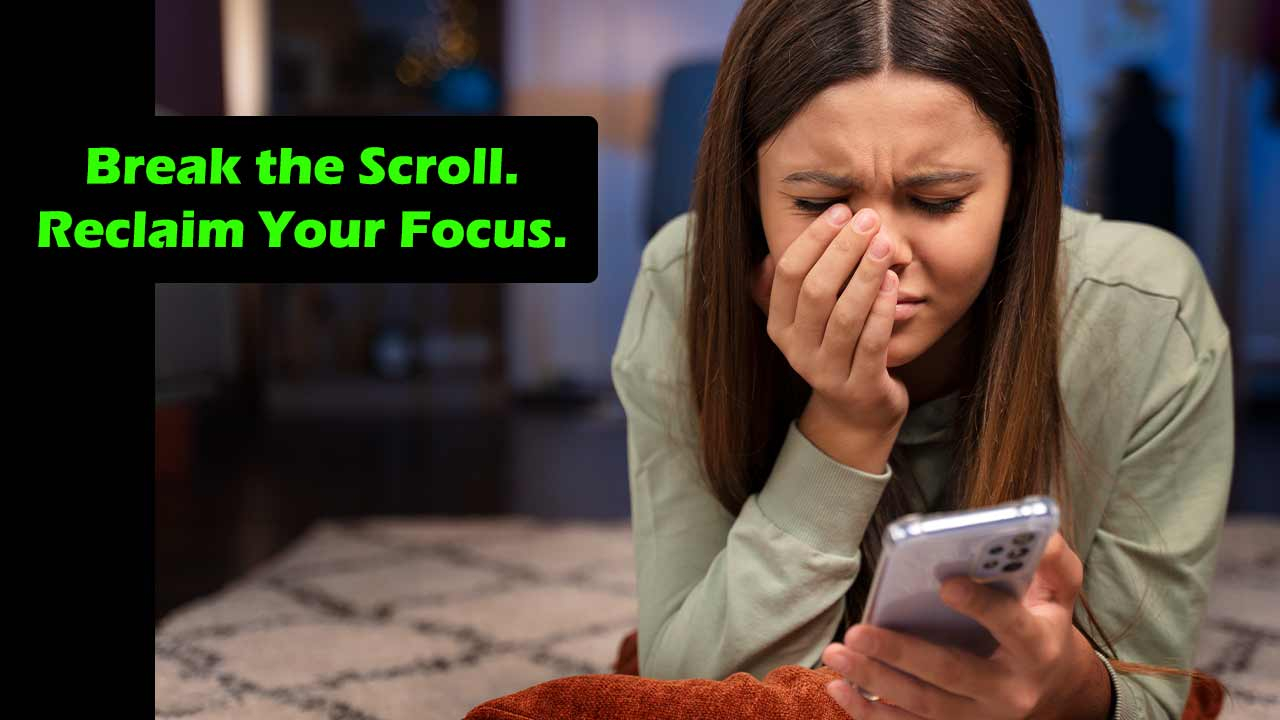Quick Read
- Doomscrolling triggers stress hormones that keep us hooked to negative content
- Set specific times for news consumption and stick to them
- Replace scrolling with purposeful activities like reading or exercise
- Use app timers and grayscale mode to reduce phone addiction
- FOMO diminishes when you focus on meaningful offline experiences
The endless scroll of tragic headlines, heated debates, and crisis updates has become a modern addiction. Doomscrolling—the compulsive consumption of negative news content—affects millions worldwide, creating a cycle of anxiety and digital dependency that’s hard to break.
This phenomenon isn’t just about spending too much time online. It’s about how constant exposure to distressing information rewires our brains, heightens our stress levels, and paradoxically makes us feel more disconnected from the world we’re trying to stay informed about.
Breaking free from doomscrolling requires understanding why we do it, implementing practical strategies to reduce the habit, and finding healthier ways to stay informed without sacrificing our mental well-being.
Why Our Brains Crave Negative Content
Our attraction to negative news isn’t a character flaw—it’s evolutionary biology working against us. The human brain developed a negativity bias to help our ancestors survive. Threats required immediate attention, while positive information could wait.
Social media platforms exploit this biological tendency. Their algorithms prioritize content that generates strong emotional responses, often favoring outrage, fear, and conflict over balanced reporting. Each scroll delivers a small hit of dopamine, creating an addictive loop similar to gambling.
Research from the American Psychological Association shows that constant exposure to negative news significantly increases stress levels. When we doomscroll, our bodies release cortisol and adrenaline—the same hormones triggered by real physical danger. Our nervous system can’t distinguish between actual threats and digital ones.
The fear of missing out compounds this problem. We convince ourselves that staying constantly updated makes us more informed citizens, but studies indicate that people who consume less news are often better informed than heavy news consumers. Quality trumps quantity when it comes to staying genuinely informed.
Practical Strategies to Break the Cycle
Create News Consumption Boundaries
Set specific times for checking news—perhaps 15 minutes in the morning and 15 minutes in the evening. Outside these windows, resist the urge to scroll through headlines. This approach helps you stay informed without letting news consumption take over your entire day.
Choose one or two reliable news sources instead of following dozens of accounts that share similar stories. Curating your information diet reduces redundancy and the overwhelming feeling that comes from seeing the same story covered from multiple angles.
Transform Your Digital Environment
Switch your phone to grayscale mode. The vibrant colors and visual stimulation of social media apps are designed to capture attention. Removing color makes your screen less appealing and reduces the subconscious urge to pick up your device.
Rearrange your apps by moving social media platforms off your home screen. This small friction makes mindless scrolling less convenient. You’ll be surprised how often you reach for your phone out of habit, only to realize you don’t actually want to use it.
Turn off non-essential notifications. Every ping triggers a small stress response and interrupts your focus. Keep notifications only for truly urgent communications like calls or important messages.
Practice Mindful Consumption
Before opening a news app or social media platform, pause and ask yourself: “What specific information am I looking for?” This simple question transforms passive scrolling into intentional seeking. If you can’t answer it, you probably don’t need to check your phone.
Set a purpose for each session. Instead of aimlessly scrolling, decide you’ll read one article about a topic you care about, check the weather, or catch up with a specific friend. Having a clear goal helps you close the app when you’ve accomplished what you set out to do.
Meaningful Activities That Replace Scrolling
Physical Movement and Exercise
When you feel the urge to doomscroll, try a five-minute walk instead. Physical movement breaks the mental loop of negative thinking and releases endorphins that naturally improve mood. Even simple stretching or doing jumping jacks can interrupt the scrolling impulse.
Regular exercise reduces cortisol levels and increases resilience to stress. You don’t need intense workouts—activities like yoga, dancing, or gardening provide similar benefits while being more accessible for people with varying fitness levels.
Creative and Learning Pursuits
Keep a book, puzzle, or sketchpad nearby. When you reach for your phone, redirect that energy toward something that engages different parts of your brain. Reading fiction, in particular, has been shown to reduce stress and improve empathy.
Learn a new skill through hands-on practice rather than watching tutorials online. Whether it’s cooking, playing an instrument, or learning a language, active learning provides the mental stimulation that scrolling temporarily satisfies.
Social Connection and Community
Call a friend or family member instead of scrolling through their social media updates. Direct communication provides deeper satisfaction than passive consumption of others’ lives. Even a five-minute conversation can be more fulfilling than an hour of scrolling.
Engage in community activities that align with your values. Volunteering, joining clubs, or participating in local events creates real-world connections that make digital interactions feel less necessary.
Managing FOMO While Reducing Screen Time
Reframe Your Relationship with Information
Accept that you can’t know everything happening in the world, and that’s okay. The most important news will find its way to you through conversations, headlines, or other sources. Missing some stories doesn’t make you uninformed—it makes you human.
Focus on local and actionable information. Instead of following global crises you can’t influence, pay attention to your community, local politics, and issues where your voice and actions can make a difference.
Create Offline Rituals
Develop morning and evening routines that don’t involve screens. This might include meditation, journaling, preparing meals, or spending time in nature. These rituals anchor your day in real-world experiences rather than digital ones.
Practice gratitude by writing down three things you appreciated each day. This simple exercise counteracts the negativity bias that doomscrolling reinforces and helps you notice positive aspects of your life.
Tools and Apps That Support Healthy Habits
Screen Time Monitoring
Use built-in screen time controls on your devices to set daily limits for social media and news apps. Start with realistic goals—if you currently scroll for three hours daily, aim for two hours initially rather than trying to eliminate it completely.
Apps like Moment or RescueTime provide detailed insights into your phone usage patterns. Understanding when and why you reach for your device helps you identify triggers and develop targeted strategies.
Digital Wellbeing Applications
Forest and similar apps gamify the process of staying off your phone. They create virtual rewards for periods of non-usage, making the absence of scrolling feel positive rather than restrictive.
News aggregators like AllSides or Ground News present multiple perspectives on stories, helping you consume news more thoughtfully rather than getting caught in algorithmic echo chambers.
Expert Insights on Long-Term Benefits
Mental health professionals emphasize that reducing doomscrolling improves sleep quality, reduces anxiety, and increases overall life satisfaction. Dr. Larry Rosen, professor emeritus at California State University, notes that people who limit news consumption report feeling more optimistic and engaged with their immediate environment.
The benefits extend beyond mental health. People who reduce excessive news consumption often report improved relationships, increased productivity, and greater sense of personal agency. When we’re not constantly overwhelmed by global problems, we have more energy to address challenges in our own lives.
Research from the University of Pennsylvania found that limiting social media use to 30 minutes per day for just one week led to reduced loneliness and depression. The participants continued these benefits even after the study ended, suggesting that breaking the doomscrolling habit creates lasting positive changes.
Taking Control of Your Digital Life
Breaking free from doomscrolling isn’t about becoming uninformed or disconnected from the world. It’s about creating a healthier relationship with information and technology that serves your wellbeing rather than undermining it.
Start small. Pick one strategy from this article and implement it for a week. Notice how it affects your mood, sleep, and overall sense of wellbeing. Gradually add more techniques as the first ones become habitual.
Remember that this is a practice, not a perfection. You’ll likely slip back into old patterns sometimes, and that’s completely normal. The goal is progress, not perfection. Each time you choose meaningful activity over mindless scrolling, you’re rewiring your brain toward healthier habits.
Your attention is valuable. By being intentional about how you spend it, you can stay informed about what matters while protecting your mental health and creating space for the experiences that truly enrich your life.
FAQs
How long does it take to break the doomscrolling habit?
Most people notice improvements in their mood and stress levels within a week of reducing news consumption. However, fully breaking the habit typically takes 2-4 weeks of consistent practice. The key is starting with small, manageable changes rather than trying to eliminate all news consumption immediately.
Can I stay informed without doomscrolling?
Absolutely. Setting specific times for news consumption—such as 15 minutes in the morning and evening—often makes people more informed than constant scrolling. Quality sources and intentional reading are more effective than passive consumption of repetitive content.
What if I feel anxious when I’m not checking the news?
This anxiety is normal and temporary. It’s similar to withdrawal symptoms from any habit. The feeling typically peaks within the first few days and then decreases. Deep breathing, physical activity, and reminding yourself that truly important news will reach you can help manage this anxiety.
Are there any news sources better for avoiding doomscrolling?
Choose sources that provide context and solutions rather than just problems. Look for newsletters that summarize weekly events, local news that covers your community, and publications that focus on constructive journalism. Avoid platforms that prioritize breaking news alerts and sensational headlines.
How do I handle FOMO when friends discuss current events?
Focus on asking questions and contributing your perspective rather than trying to know every detail. Often, people appreciate thoughtful questions more than someone who simply repeats information they’ve read. Your unique insights and experiences are more valuable than being a news encyclopedia.




